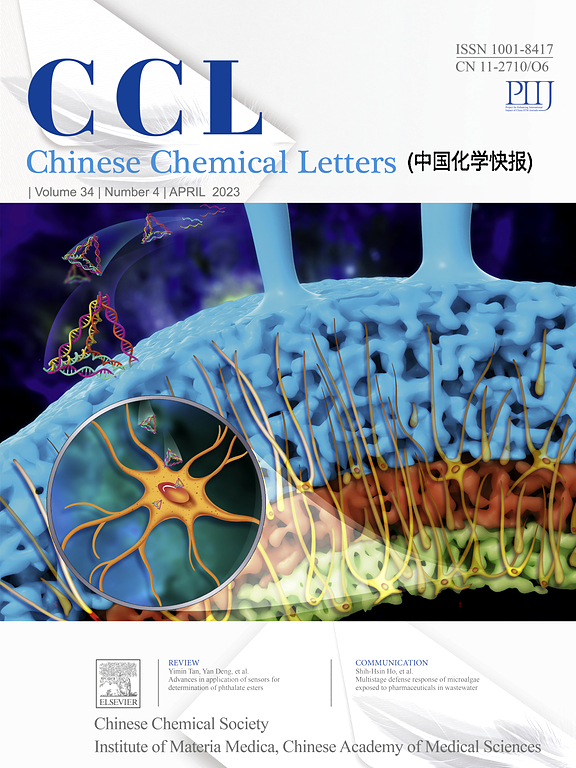位点特异性表面胺化策略促进了酶在氢键有机框架内的仿生包封
IF 8.9
1区 化学
Q1 CHEMISTRY, MULTIDISCIPLINARY
引用次数: 0
摘要
氢键框架(HOF)由于其合成条件温和、孔结构适宜、骨架生物相容性好等优点,为酶的包封和稳定构象提供了一个有吸引力的平台。然而,这种HOF方法的效率依赖于酶客体与配体前体之间的界面相互作用,限制了其对具有不同表面化学性质的酶的适应性。在这项研究中,我们报道了一种位点特异性表面修饰策略,可以积极调整酶的表面电荷,促进酶在HOF内的仿生包封。实验结果和计算模拟均表明,酶表面酸性残基的位点特异性胺化作用通过协同静电和氢键相互作用促进了水溶液中羧基配体前体的界面积累。这极大地促进了围绕氨化酶生物模板的多孔HOF的原位生长,酶负载效率高达100% %。所得的氢键生物杂化框架(HBF)在保持高生物催化功能的同时,在恶劣条件下表现出优异的稳定性。利用GOx-NH2@HBF-1的显著催化活性和h2o2敏感QD,制备了高灵敏度的葡萄糖荧光传感器,线性范围宽(5 - 2000 µmol/L),定量限低(5 µmol/L)。本研究提出了一种简单而有效的酶表面工程方法,将酶整合到HOF中,为构建多功能HOF生物复合材料开辟了新的途径。本文章由计算机程序翻译,如有差异,请以英文原文为准。

Site-specific surface amination strategy facilitates biomimetic encapsulation of enzymes within hydrogen-bonded organic framework
Hydrogen-bonded framework (HOF) offers an attractive platform to encapsulate enzymes and stabilize their conformation, due to the advantages of mild synthesis conditions, tailorable pore structure, and backbone biocompatibility. However, the efficiency of this HOF approach relies on the interfacial interactions between enzyme guest and the ligand precursors, limiting its adaptability to enzymes with varying surface chemistry property. In this study, we report a site-specific surface modification strategy to positively tailor the enzyme surface charge, facilitating the biomimetic encapsulation of enzymes within HOF in situ. Both experimental results and computational simulation reveal that site-specific amination of enzyme surface’s acidic residues contributes to the interfacial accumulation of carboxylic ligand precursors in aqueous solutions via synergistic electrostatic and hydrogen bonding interactions. This substantially facilitates the in situ growth of porous HOF surrounding the aminated enzyme biotemplates, with up to 100 % enzyme loading efficiency. The resultant hydrogen-bonded biohybrid framework (HBF) retains high biocatalytic functions while exhibiting exceptional stability under harsh conditions. By leveraging the marked catalytic activity of GOx-NH2@HBF-1 and a H2O2-sensitive QD, a highly sensitive glucose fluorescence sensor is fabricated with a wide linear range (5–2000 µmol/L) and a low quantification limit of 5 µmol/L. This work presents a simple yet effective enzyme surface engineering approach for integrating enzyme into HOF, opening new avenues for the construction of multifunctional HOF biocomposites.
求助全文
通过发布文献求助,成功后即可免费获取论文全文。
去求助
来源期刊

Chinese Chemical Letters
化学-化学综合
CiteScore
14.10
自引率
15.40%
发文量
8969
审稿时长
1.6 months
期刊介绍:
Chinese Chemical Letters (CCL) (ISSN 1001-8417) was founded in July 1990. The journal publishes preliminary accounts in the whole field of chemistry, including inorganic chemistry, organic chemistry, analytical chemistry, physical chemistry, polymer chemistry, applied chemistry, etc.Chinese Chemical Letters does not accept articles previously published or scheduled to be published. To verify originality, your article may be checked by the originality detection service CrossCheck.
 求助内容:
求助内容: 应助结果提醒方式:
应助结果提醒方式:


